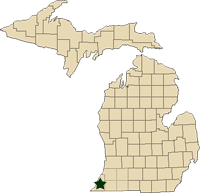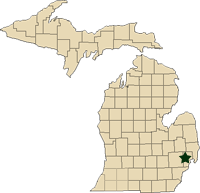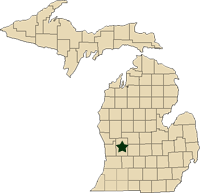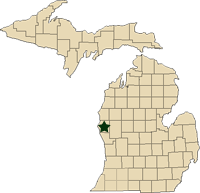Regional reports on Michigan vegetables – June 8, 2011
MSU Extension educators’ pest and vegetable updates for Michigan.
This week’s regional reports:
- Southwest Michigan – Ron Goldy
- East Michigan – Hannah Stevens
- Grand Rapids Area – Bill Steenwyk
- West Central Michigan – Norm Myers
Southwest Michigan – Ron Goldy, Michigan State University Extension
|
Weather
Temperatures averaged above normal with highs ranging from 77 to 94oF and lows from 52 to 74oF. There was only a trace of precipitation for the area. While there is still standing water and wet soils in some fields, many sites are in need of moisture.
Field activity
Planting continues. Many transplants show signs of stress from too much time in greenhouse trays. Some are in flower, older leaves are yellowing, leaves in general are small and transplants are overly tall.
Crop reports
Asparagus harvest is complete on some fields and weed control applications are being made. Harvest will probably continue through the weekend, primarily for direct market sales. Asparagus beetles are active.
Peas are in bloom.
Potatoes are 14 to 16 inches tall. All stages of Colorado potato beetles can be found.
Tomatoes grown in tunnels have 2-inch diameter fruit and are on their third tie. Non-tunneled tomatoes are close to bloom and are at first tie. Planting continues.
Pepper and eggplant transplants continue to be set out.
Sweet corn in tunnels is at tassel emergence. Early planted fields are 16 inches tall.
Zucchini and yellow squash transplants in tunnels are at first harvest. Direct seeding continues.
Pumpkin and fall squash planting will be mostly complete this week.
Tunneled cucumber and cantaloupe are in bloom.
Growers need to scout vine crop fields for cucumber beetles since they are active.
East Michigan – Hannah Stevens, Michigan State University Extension
|
Field conditions
Differences in soil texture, structure and drainage are making huge impacts in field and crop management. With no rainfall this week and temperatures topping 93°F yesterday (June 7), farmers have been working fields in the past few days and nights and cultivating existing crops to break up crusts and manage weeds. Some fields remain too wet to work properly. Approaching rainfall will be helpful in crop establishment and cooler temperatures will reduce stress on newly established transplants, which is considerable.
Crop conditions
Sweet corn stands are looking spotty in some areas. European corn borer numbers are up with an average of eight moths per trap. Established tomatoes are growing very quickly, but some newly set-out plants were stressed and growers are hoping they will resume new growth. Cutworms have destroyed some new pepper transplants. First snap beans appear to be healthy. Cabbage is reported to be making good progress. There has been some replanting of hard squash and pumpkins and possibly sweet corn.
Grand Rapids Area – Bill Steenwyk, Michigan State University Extenion
|
It has been dry from Newaygo south to Van Buren County. Temperatures have been warm, changing to a muggy, 90-plus degree heat wave in the past few days. Just as in weeks past, it is relatively warmer in the north than in the southern portions of the region. Comparing base 50 growing degree days to the cool, 2009 season, Fremont is at 127 percent, Hudsonville is at 111 percent, Fennville is at 109 percent, and Lawton, at 101 percent, is now about even with 2009.
Field work is moving forward at a rapid pace. Celery transplanting is about 60 percent complete. A few aphids have appeared, as have aster leafhoppers. An MSU lab test indicates 0 percent infectivity for the one sample submitted. Onions are growing rapidly. A number of stands were thinned by earlier wet soils. Weed infestations are and will be a challenge in some fields. Radishes are being harvested and planted with field wetness determining yield and quality. The lettuce that I have seen looks good.
Cabbage transplanting is over 50 percent complete. The crop looks to be doing well. Squash planting continues. Sweet corn is growing well and planting has moved ahead rapidly.
West Central Michigan – Norm Myers, Michigan State University Extension
|
Unlike southern Michigan, we need rain. Weather has been consistently hot and dry in our area. Irrigation is now operating in many fields where it is available.
Asparagus yields are now being affected by the lack of water, particularly on lighter soils. Yields are ahead of the record lows of last year, but don’t approach the very good yields we experienced in 2008. Most growers feel that we are approaching the two-thirds harvested point. Certainly a short labor supply has played a role in cutting yields over what they could have been if we had had adequate harvest labor. Fresh prices have not faltered since the beginning of the seasons, but quality has been a struggle in the heat, so I see more asparagus being diverted to processing.
On the pest front, common asparagus beetle pressure has been steady from the beginning of the season, but is worse in very hot weather. Some dark-sided cutworm did show up, but no more than normal. There is no sign of aecial rust lesions, but they are due to show up any time. There is a healthy flush of weeds coming on that will have to be dealt with when harvest finishes.
Carrot growers have replanted some fields, but in general stands are acceptable. Small grain cover crops have all been killed and preemergence weed control applied where that is part of grower weed management strategy. Scouts are finding a few aster leafhoppers, but generally below the generic threshold. I would like to catch enough to do an aster leafhopper index, but scouts can’t point me to a likely field to catch the necessary 50 aster leafhoppers. I have also had one report of springtail activity in carrots.
Most winter squash, Jack O’Lantern pumpkins and early snap beans have been planted. Growers have started planting the processing zucchini crop, which is more staggered to facilitate harvesting over a longer period of time.



 Print
Print Email
Email
 East Michigan
East Michigan Grand Rapids Area
Grand Rapids Area



